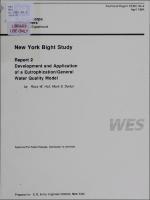Please use this identifier to cite or link to this item:
https://hdl.handle.net/11681/12592Full metadata record
| DC Field | Value | Language |
|---|---|---|
| dc.contributor | United States. Army. Corps of Engineers. New York District | - |
| dc.contributor.author | Hall, Ross W. | - |
| dc.contributor.author | Dortch, Mark S. | - |
| dc.date.accessioned | 2016-07-06T14:23:35Z | - |
| dc.date.available | 2016-07-06T14:23:35Z | - |
| dc.date.issued | 1994-04 | - |
| dc.identifier.uri | http://hdl.handle.net/11681/12592 | - |
| dc.description | Technical Report | - |
| dc.description | Abstract: The New York Bight (NYB) Water Quality Model Study was an investigation of the technical feasibility of applying a numerical three-dimensional (3-D) water quality model to assess the impacts of natural and human activities on the NYB. For this study, the NYB consisted of tidally influenced estuaries, harbors, and bays; Long Island Sound; the Apex region between the open waters of the Bight and the harbors/estuaries; and the Bight, which for this study extended from Cape May, New Jersey, northeasterly approximately 550 km along the coastline to Nantucket Island, Massachusetts, and approximately 160 km offshore to the continental shelf. The depth of the study site varied from 3 m to near 900 m seaward toward the continental shelf. The modeling technology recently developed for the Chesapeake Bay was applied to the Bight. This technology consisted of 3-D, time-varying hydrodynamic and water quality models. The model employed a 76 x 45 curvilinear or boundary-fitted, planform grid and 10 stretched (sigma) coordinate layers for the vertical dimension. The summer hypoxia event of 1976 was selected for the water quality model application, where simulations extended from 15 April through 30 September 1976. The model compared relatively well with observations in the Bight and successfully captured the summer hypoxia of 1976. Simulated net plankton, dissolved organic carbon (DOC), and particulate organic carbon (POC) were generally underestimated. Simulated and measured dissolved oxygen (DO) indicated relatively close agreement except in Raritan Bay, where a nanoplankton bloom greatly inflated the simulated DO concentrations. Sensitivity tests were conducted to examine the importance of the benthic sediment oxygen demand (SOD) and ocean nitrogen boundary conditions. An SOD value of zero increased the DO 3 percent Bight-wide while an increase in SOD by a factor of 10 decreased the DO 15 percent. Importantly, the most detectable decrease in DO (38 percent) occurred in the more shallow bays and estuaries. Model DO was relatively insensitive to the nitrogen seaward boundary conditions. Demonstration scenarios included external load increase and reduction as well as use of the model for investigating the cause of the New Jersey nearshore hypoxia. Constant external loads were varied for the Transect, New Jersey Coast, and Long Island Coast. Decreasing the external load to zero had the effect of decreasing algal, DOC, and POC concentrations. Although organic carbon decreased, the net effect of these changes resulted in a slight decrease in DO. The decrease in algae had greater impact on decreasing DO, compared with the effect that decreasing organic carbon had on increasing DO. Dramatic loading increases by a factor of 100 caused slight DO decrease Bight-wide and a substantial DO decrease in the Transect. Model simulations revealed that low DO simulated off the coast of New Jersey was the result of three major interacting components: the prevailing southwest to northeast residual flows, DOC and DO boundary conditions along the southwest ocean boundary of the model grid, and SOD. Of these three processes, the advection of low DO had the greatest effect. NOTE: This file is large. Allow your browser several minutes to download the file. | - |
| dc.publisher | Coastal Engineering Research Center (U.S.) | - |
| dc.publisher | Engineer Research and Development Center (U.S.) | - |
| dc.relation | http://acwc.sdp.sirsi.net/client/en_US/search/asset/1032283 | - |
| dc.relation.ispartofseries | Technical report (U.S. Army Engineer Waterways Experiment Station) ; CERC-94-4 rept. 2. | - |
| dc.rights | Approved for public release; distribution is unlimited. | - |
| dc.source | This Digital Resource was created from scans of the Print Resource | - |
| dc.subject | Dissolved oxygen | - |
| dc.subject | Eutrophication | - |
| dc.subject | Models | - |
| dc.subject | Modelling | - |
| dc.subject | New York Bight | - |
| dc.subject | Nitrogen | - |
| dc.subject | Water quality | - |
| dc.subject | Marine ecology | - |
| dc.title | New York Bight Study. Report 2, Development and application of a eutrophication/general water quality model | - |
| dc.type | Report | en_US |
| Appears in Collections: | Technical Report | |
Files in This Item:
| File | Description | Size | Format | |
|---|---|---|---|---|
| TR-CERC-94-4-R2.pdf | 56.74 MB | Adobe PDF |  View/Open |